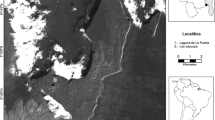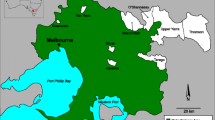Abstract
Helicobacter spp. colonize the gastrointestinal tract of humans and animals and have been associated with gastrointestinal diseases. Antarctic habitats are considered pristine ecosystems, but the increase in human activity could be introducing human bacteria hosted into waters and wildlife. However, Helicobacter spp. occurrence has not been studied in Antarctica. The aim of our study was to detect the Helicobacter DNA in different water sources and penguin feces from Greenwich, Dee and Barrientos Islands during summer of 2012 and 2013. High Helicobacter proportion was observed in water sources amplifying the 16S rRNA (33/40) and 23S rRNA genes (37/40) by semi-nested PCR. Similar results were observed in feces from Gentoo penguins (16S rRNA: 32/39, and 23S rRNA: 28/39) and Chinstrap penguins (16S rRNA: 16/17, and 23S rRNA: 15/17) by PCR. The phylogenetic relationship of 16S rRNA and 23S rRNA sequences from penguin feces was closely related to Helicobacter brantae. Analyses of 16S rRNA sequences showed that the majority of water samples are related to penguin (3/6) and Helicobacter pylori (2/6) sequences, but the 23S rRNA sequences matched with Campylobacter and Arcobacter. These results show for the first time the presence of the genus Helicobacter in different Antarctica water sources and in Gentoo and Chinstrap penguin feces. A few 16S rRNA sequences are very closely related to H. pylori, but specific glmM and ureA H. pylori genes were not detected. More studies are needed to determine the Helicobacter species present in this ecosystem and to establish the human impact in these Antarctic Islands.



Similar content being viewed by others
References
Ancel A, Beaulieu M, Gilbert C (2013) The different breeding strategies of penguins: a review. C R Biol 336:1–12
Azevedo NF, Almeida C, Fernandes I, Cerqueira L, Dias S, Keevil CW, Vieira MJ (2008) Survival of gastric and enterohepatic Helicobacter spp. in water: implications for transmission. Appl Environ Microbiol 74:1805–1811
Baker GC, Tow LA, Cowan DA (2003) PCR-based detection of non-indigenous microorganisms in ‘pristine’ environment. J Microbiol Methods 53:157–164
Barbosa A (2011) Effects of climate change on Antarctic penguins. Ecosystems 20:33–41
Bargagli R (2008) Environmental contamination in Antarctic ecosystems. Sci Total Environ 400:212–226
Bonnedahl J, Broman T, Waldenström J, Palmgren H, Niskanen T, Olsen B (2005) In search of human-associated bacterial pathogens in Antarctic wildlife: report from six penguin colonies regularly visited by tourists. Ambio 34:430–432
Carbone M, Maugeri TL, Gugliandolo C, La Camera E, Biondo C, Fera MT (2005) Occurrence of Helicobacter pylori DNA in the coastal environment of southern Italy (straits of Messina). J Appl Microbiol 98:768–774
Cellini L, Grande R, Di Campli E, Di Bartolomeo S, Di Giulio M, Traini T, Trubiani O (2008) Characterization of an Helicobacter pylori environmental strain. J Appl Microbiol 105:761–769
Cole JR, Wang Q, Fish JA, Chai B, McGarrell DM, Sun Y, Brown CT, Porras-Alfaro A, Kuske CR, Tiedje JM (2014) Ribosomal Database Project: data and tools for high throughput rRNA analysis. Nucleic Acids Res 42(database issue):D633–D642
Collado L, Figueras MJ (2011) Taxonomy, epidemiology, and clinical relevance of the genus Arcobacter. Clin Microbiol Rev 24:174–192
Cowan DA, Chown SL, Convey P, Tuffin M, Hughes K, Pointing S, Vincent WF (2011) Non-indigenous microorganisms in the Antarctic: assessing the risks. Trends Microbiol 19:540–548
Dewar ML, Arnould JPY, Dann P, Trathan P, Groscolas R, Smith S (2013) Interspecific variations in the gastrointestinal microbiota in penguins. MicrobiologyOpen 2:195–204
Dewhirst FE, Seymour C, Fraser GJ, Paster BJ, Fox JG (1994) Phylogeny of Helicobacter isolates from bird and swine feces and description of Helicobacter pametensis sp. nov. Int J Syst Bacteriol 44:553–560
Dewhirst FE, Shen Z, Scimeca MS, Stokes LN, Boumenna T, Chen T, Paster BJ, Fox JG (2005) Discordant 16S and 23S rRNA gene phylogenies for the genus Helicobacter implications for phylogenetic inference and systematics. J Bacteriol 187:6106–6118
Fox JG, Taylor NS, Howe S, Tidd M, Xu S, Paster BJ, Dewhirst FE (2006) Helicobacter anseris sp. nov. and Helicobacter brantae sp. nov., isolated from feces of resident Canada geese in the greater Boston area. Appl Environ Microbiol 72:4633–4637
García A, Salas-Jara MJ, Herrera C, González C (2014) Biofilm and Helicobacter pylori: from environment to human host. World J Gastroenterol 20:5632
García-Amado MA, Bozo-Hurtado L, Astor Y, Suárez P, Chistoserdov A (2011) Denaturing gradient gel electrophoresis analyses of the vertical distribution and diversity of Vibrio spp. populations in the Cariaco Basin. FEMS Microbiol Ecol 77:347–356
Germani Y, Dauga C, Duval P, Huerre M, Levy M, Pialoux G, Sansonetti P, Grimont PAD (1997) Strategy for the detection of Helicobacter species by amplification of 16 s rRNA genes and identification of H. felis in a human gastric biopsy. Res Microbiol 148:315–326
Goldman CG, Matteo MJ, Loureiro JD, Degrossi J, Teves S, Heredia SR, Alvarez K, González AB, Catalano M, Boccio J, Cremaschi G, Solnick JV, Zubillaga MB (2009) Detection of Helicobacter and Campylobacter spp. from the aquatic environment of marine mammals. Vet Microbiol 133:287–291
Grondahl F, Sidenmark J, Thomsen A (2009) Survey of waste water disposal practices at Antarctic research stations. Polar Res 28:298–306
Hammer Ø, Harper DAT, Ryan PD (2001) PAST: paleontological statistics software package for education and data analysis. Palaeontologia Electronica 4:1–9
Hughes KA, Thompson A (2004) Distribution of sewage pollution around a maritime Antarctic research station indicated by faecal coliforms, Clostridium perfringens and faecal sterol markers. Environ Pollut 127:315–321
IAATO (International Association of Antarctica Tour Operators) (2014) 2012–2013 Tourism statistics. http://iaato.org/es/tourism-statistics. Accessed 03 July 2014
Kansau I, Raymond J, Bingen E, Courcoux P, Kalach N, Bergeret M, Braimi N, Dupont C, Labigne A (1996) Genotyping of Helicobacter pylori isolates by sequencing of PCR products and comparison with the RAPD technique. Res Microbiol 147:661–669
Kusters JG, van Vliet AH, Kuipers EJ (2006) Pathogenesis of Helicobacter pylori infection. Clin Microbiol Rev 19:449–490
Lawson AJ, On SL, Logan JM, Stanley J (2001) Campylobacter hominis sp. nov., from the human gastrointestinal tract. Int J Syst Evol Microbiol 51:651–660
Metcheva R, Yurukova L, Teodorova S, Nikolova E (2006) The penguin feathers as bioindicator of Antarctica environmental state. Sci Total Environ 362:259–265
Moreno Y, Ferrús MA (2012) Specific detection of cultivable Helicobacter pylori cells from wastewater treatment plants. Helicobacter 17:327–332
Parte AC (2014) LPSN—list of prokaryotic names with standing in nomenclature. Nucleic Acids Res 42:D613–D616. http://www.bacterio.net. Accessed Dec 2015
Peek RM, Miller GG, Tham KT, Perez-Perez GI, Cover TL, Atherton JC, Dunn GD, Blaser MJ (1995) Detection of Helicobacter pylori gene expression in human gastric mucosa. J Clin Microbiol 33:28–32
Pruesse E, Peplies J, Glöckner FO (2012) SINA: accurate high-throughput multiple sequence alignment of ribosomal RNA genes. Bioinformatics 28:1823–1829
Santiago P, Moreno Y, Ferrús MA (2015) Identification of viable Helicobacter pylori in drinking water supplies by cultural and molecular techniques. Helicobacter. doi:10.1111/hel.12205
Sjoling S, Cowan DA (2000) Detecting human bacterial contamination in Antarctic soils. Polar Biol 23:644–650
Tamura K, Peterson D, Peterson N, Stecher G, Nei M, Kumar S (2011) MEGA5: molecular evolutionary genetics analysis using maximum likelihood, evolutionary distance, and maximum parsimony methods. Mol Biol Evol 28:2731–2739
Tin T, Fleming ZL, Hughes KA, Ainley DG, Convey P, Moreno CA, Pfeiffer S, Scott J, Snape I (2009) Impacts of local human activities on the Antarctic environment. Antarctic Sci 21:3–33
Twing KI, Kirchman DL, Campbell BJ (2011) Temporal study of Helicobacter pylori presence in coastal freshwater, estuary and marine waters. Water Res 45:1897–1905
Acknowledgments
This study was accomplished in the Venezuelan Institute for Scientific Research and found by the Venezuelan Antarctic Program, the Ecuadorian Antarctic Institute and Secretariat of Science, Technology and Innovation of the Republic of Ecuador. The authors gratefully acknowledge the Logistics team of Ecuadorian base Pedro Vicente Maldonado, Soraya Silva Ph.D and Nory Gonzales by the help with the sampling collection, Juan Manuel Carrera for the help with map elaboration and M. López Gasca for English improvements of the manuscript.
Author information
Authors and Affiliations
Corresponding author
Rights and permissions
About this article
Cite this article
Cunachi, A.M., Fernández-Delgado, M., Suárez, P. et al. Detection of Helicobacter DNA in different water sources and penguin feces from Greenwich, Dee and Barrientos Islands, Antarctica. Polar Biol 39, 1539–1546 (2016). https://doi.org/10.1007/s00300-015-1879-5
Received:
Revised:
Accepted:
Published:
Issue Date:
DOI: https://doi.org/10.1007/s00300-015-1879-5




